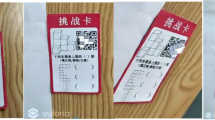Abstract
This paper describes the development of a prototype for an AR application, which supports volume calculation and spatial understanding for mathematics in vocational educations in Denmark. Teaching of spatial shapes and their properties are done mainly in a two-dimensional space on paper. To mitigate the inherent contradiction of learning about 3D-figures on paper, we set forth to develop an application, which focus on visualizing 3D-objects with the use of handheld AR. The application is developed with the iterative design process where the development of low- and high-fidelity prototypes have been essential for improving and testing the product. From testing it was noted that there was expressed excitement for the visualization of the 3D-objects through AR and how real they seemed. Especially the visualizations of the figures size and the size compared to its volume. From test results the AR visualization of 3D-objects and interaction with them helped test subjects to better understand the spatiality of the shown object. With the application they were able to “see the unseen” [6], which helped their understanding of spatial objects. We propose the use of AR technology to be further utilized as a natural tool in relevant subjects, where a visualization can promote or enhance a better understanding of a topic. On the top of this, AR contributes to the learning experience, which will vast and remain with the users.
Access this chapter
Tax calculation will be finalised at checkout
Purchases are for personal use only
Similar content being viewed by others
References
Anderson, S.P.: Chapter 1. Learning and thinking with things. In: Designing for Internet of Things. O'Reilly Media (2015). https://www.oreilly.com/library/view/designing-for-the/9781491971468/ch01.html. Accessed 15 Jan 2022
Blender Foundation, Blender 3D. https://www.blender.org/. Accessed 19 Feb 2022
Cahyono, B., Firdaus, M.B., Budiman, E., Wati, M.: Augmented reality applied to geometry education. In: The 2nd East Indonesia Conference on Computer and Information Technology (2018). https://doi.org/10.1109/EIConCIT.2018.8878553
Cheng, K.H., Tsai, C.C.: Affordances of augmented reality in science learning: suggestions for future research. J. Sci. Educ. Technol. 22, 449–462 (2013). https://doi.org/10.1007/s10956-012-9405-9
Coimbra, T., Cardoso, T., Mateus, A.: Augmented reality: an enhancer for higher education students in math’s learning? Procedia Comput. Sci. 67, 332–339 (2015). https://doi.org/10.1016/j.procs.2015.09.277
Dunleavy, M.: Design principles for augmented reality learning. TechTrends 58(1), 28–34 (2013). https://doi.org/10.1007/s11528-013-0717-2
Giant Lazer Seeing the world of geometry with Augmented Reality. https://giantlazer.com/seeing-the-world-of-geometry-with-augmented-reality/. Accessed 2 Feb 2022
Fullerton, T.: Game Design Workshop. 2nd edn. Elsevier, United States (2008). https://doi.org/10.1201/b13172
Klopfer, E.: Augmented Learning: Research and Design of Mobile Educational Games. The MIT Press, London (2008)
Majgaard, G., Larsen, L.J., Lyk, P., Lyk, M: Seeing the unseen – spatial visualization of the solar system with physical prototypes and augmented reality. international J. Des. Learn. 8(2), 95–109 (2017). https://doi.org/10.14434/ijdl.v8i2.22368
Milgram, P., Takemura, H., Utsumi, A., Kishino, F: Augmented reality: class of displays on the reality-virtuality continuum. Telemanipulator and telepresence technologies SPIE 2351, 282–292 (1994). https://doi.org/10.1117/12.197321
Murphy, B., Spiegel, E.: Snapchat, Snapchat Inc. https://www.snapchat.com/. Accessed 25 Jan 2022
Niantic, Pokémon GO. https://pokemongolive.com/en/. Accessed 25 Jan 2022
Preece, J., Rogers, Y., Sharp, H.: Interaction Design Beyond Human-Computer Interaction, 4th edn. WILEY, Chichester (2015)
Rossano, V., Lanzilotti, R., Cazzolla, Antonio., Roselli, T.: Augmented reality to support geometry learning. IEEE Access 8, 107772–107780 (2020). https://doi.org/10.1109/ACCESS.2020.3000990
Shelton, B.E., Hedley, N.R.: Using augmented reality for teaching earth-sun relationships to undergraduate geography student. In: The First IEEE International Workshop Augmented Reality Toolkit (2002). https://doi.org/10.1109/ART.2002.1106948
Song, E., Susub, N., Sihes, A.J., Alwee, R., Yonos, Z.M.: Design and development of learning mathematics game for primary school using handheld augmented reality. OP Conf. Ser. Mater. Sci. Eng. 979(1), 1–10 (2020). https://doi.org/10.1088/1757-899X/979/1/012014
Pedersen, J.B., Andersen, S., Majgaard, G.: Design of trigonometry apps for vocational education. In: IASTED International Conference. HCI (2012). https://doi.org/10.2316/P.2012.772-020
Unity Technologies, Unity. https://unity.com/. Accessed 19 Jan 2022
Unity Technologies, Multiplatform. https://unity.com/features/multiplatform. Accessed 19 Jan 2022
Vuforia Engine. https://developer.vuforia.com/. Accessed 19 Jan 2022
Vuforia Developer Library, Best Practices for Designing and Developing Image-Based Targets. https://library.vuforia.com/features/images/image-targets/best-practices-for-designing-and-developing-image-based-targets.html. Accessed 13 Jan 2022
Vuforia Developer Library, Vuforia Target Manager. https://library.vuforia.com/articles/Training/Getting-Started-with-the-Vuforia-Target-Manager.html. Accessed 19 Feb 2022
Acknowledgments
Thank you to teacher Søren Damgaard for the basic idea for the application. Thank you to co supervisor Patricia Bianca Lyk, for supervising the project and project report. A big thank goes to Simone’s dear friend Nina Weilbaecher for doing the graphical work on Fig. 2. Special thanks to Lasse Juel Larsen for internal perusal and proofreading in the writing of this paper.
Author information
Authors and Affiliations
Corresponding author
Editor information
Editors and Affiliations
Rights and permissions
Copyright information
© 2022 Springer Nature Switzerland AG
About this paper
Cite this paper
Dalager, S., Majgaard, G. (2022). Development of an Educational AR Tool for Visualization of Spatial Figures and Volume Calculation for Vocational Education. In: Chen, J.Y.C., Fragomeni, G. (eds) Virtual, Augmented and Mixed Reality: Applications in Education, Aviation and Industry. HCII 2022. Lecture Notes in Computer Science, vol 13318. Springer, Cham. https://doi.org/10.1007/978-3-031-06015-1_2
Download citation
DOI: https://doi.org/10.1007/978-3-031-06015-1_2
Published:
Publisher Name: Springer, Cham
Print ISBN: 978-3-031-06014-4
Online ISBN: 978-3-031-06015-1
eBook Packages: Computer ScienceComputer Science (R0)




